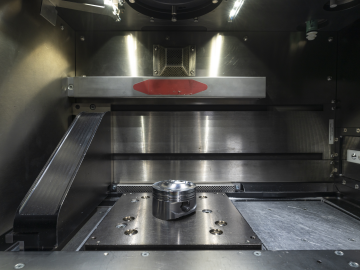
Filter News
Area of Research
News Type
News Topics
- (-) Biomedical (6)
- (-) Clean Water (5)
- (-) Composites (6)
- (-) Frontier (18)
- (-) Isotopes (10)
- (-) Materials Science (17)
- (-) Microscopy (8)
- (-) Transportation (20)
- 3-D Printing/Advanced Manufacturing (20)
- Advanced Reactors (2)
- Artificial Intelligence (27)
- Big Data (12)
- Bioenergy (24)
- Biology (31)
- Biotechnology (6)
- Buildings (14)
- Chemical Sciences (23)
- Computer Science (29)
- Coronavirus (4)
- Critical Materials (6)
- Cybersecurity (11)
- Education (3)
- Emergency (1)
- Energy Storage (22)
- Environment (46)
- Exascale Computing (15)
- Fossil Energy (2)
- Fusion (10)
- Grid (16)
- High-Performance Computing (31)
- Hydropower (3)
- Irradiation (1)
- Machine Learning (15)
- Materials (55)
- Mathematics (2)
- Mercury (3)
- Microelectronics (2)
- Molten Salt (1)
- Nanotechnology (7)
- National Security (21)
- Neutron Science (35)
- Nuclear Energy (19)
- Partnerships (24)
- Physics (16)
- Polymers (4)
- Quantum Computing (12)
- Quantum Science (9)
- Security (3)
- Simulation (28)
- Software (1)
- Space Exploration (4)
- Summit (9)
Media Contacts

Speakers, scientific workshops, speed networking, a student poster showcase and more energized the Annual User Meeting of the Department of Energy’s Center for Nanophase Materials Sciences, or CNMS, Aug. 7-10, near Market Square in downtown Knoxville, Tennessee.

Researchers at ORNL are developing advanced automation techniques for desalination and water treatment plants, enabling them to save energy while providing affordable drinking water to small, parched communities without high-quality water supplies.

Outside the high-performance computing, or HPC, community, exascale may seem more like fodder for science fiction than a powerful tool for scientific research. Yet, when seen through the lens of real-world applications, exascale computing goes from ethereal concept to tangible reality with exceptional benefits.

Subho Mukherjee, an R&D associate in the Vehicle Power Electronics Research group at the Department of Energy’s Oak Ridge National Laboratory, has been elevated to the grade of senior member of the Institute of Electrical and Electronics Engineers.

Madhavi Martin brings a physicist’s tools and perspective to biological and environmental research at the Department of Energy’s Oak Ridge National Laboratory, supporting advances in bioenergy, soil carbon storage and environmental monitoring, and even helping solve a murder mystery.

Technologies developed by researchers at ORNL have received six 2023 R&D 100 Awards.

It was reading about current nuclear discoveries in textbooks that first made Ken Engle want to work at a national lab. It was seeing the real-world impact of the isotopes produced at ORNL

Mirko Musa spent his childhood zigzagging his bike along the Po River. The Po, Italy’s longest river, cuts through a lush valley of grain and vegetable fields, which look like a green and gold ocean spreading out from the river’s banks.

Eric Myers of ORNL has been named a senior member of the Institute of Electrical and Electronics Engineers, effective June 21.

Dean Pierce of ORNL and a research team led by ORNL’s Alex Plotkowski were honored by DOE’s Vehicle Technologies Office for development of novel high-performance alloys that can withstand extreme environments.


